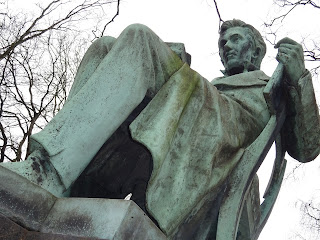I am grateful to Zondervan for sending this book to me, presumably for review.
 |
|
© Terry J. Wright, 2016 |
 |
| © Terry J. Wright, 2023 |
I described K:ASL as a ‘biography-cum-introduction’ rather than a biography or an introduction because Backhouse’s book straddles the distance between the two genres. Naturally, the majority of the work focuses on the life story of Kierkegaard the man in all his glorious complexity. Backhouse begins with scenes from Kierkegaard’s funeral and an account of his school life before delivering a more conventional chronological presentation of his life. Kierkegaard’s attacks on the Danish Lutheran Church were explosive and frequent, many establishment figures found him inscrutable and not a little irksome (as well as someone to mock), and his love life was complicated to say the least – Backhouse’s portrait vividly captures something of Kierkegaard’s witty, introspective persona, his ambitions often disclosed through pseudonymous works, his intense devotion to God. The final chapter sees Backhouse moving beyond the purely biographical to outline Kierkegaard’s impact on subsequent scholars and authors, including, among others, Karls Jaspers and Barth, Hannah Arendt, Richard Wright, and even the band Arcade Fire, showing how the Dane’s thought – which centres on the human subject before God – resonates deeply with people across the disciplinary and religious spectra. In a final section, Backhouse summarises each of Kierkegaard’s writings; I found these overviews especially welcome and interesting, and undoubtedly will return to them if ever I study Kierkegaard in more depth or, in my role as a proofreader and indexer, work on monographs relating to him.
 |
| A lock of Kierkegaard's hair / © Terry J. Wright, 2023 |
K:ASL is an engrossing read, though, as one might
expect, any book that has a figure like Søren Kierkegaard as
its subject is not going to avoid complicated and challenging concepts that
take time to digest. Backhouse’s prose is lively and engaging, though occasionally
his present-tense narration (e.g., ‘May 5, 1838. Søren celebrates his birthday’, p. 85) jars – this approach seems slightly too
informal to me. That said, Backhouse makes clear this is not ‘another academic
biography’ but one intended for ‘educated nonspecialists who do not need to
know, and do not care, about the depths of Kierkegaard’s intellectual
development or the minutiae of his cultural context in Golden Age Denmark’ (pp.
12–13). With this in mind, I say Backhouse successfully achieves his goal.
No comments:
Post a Comment